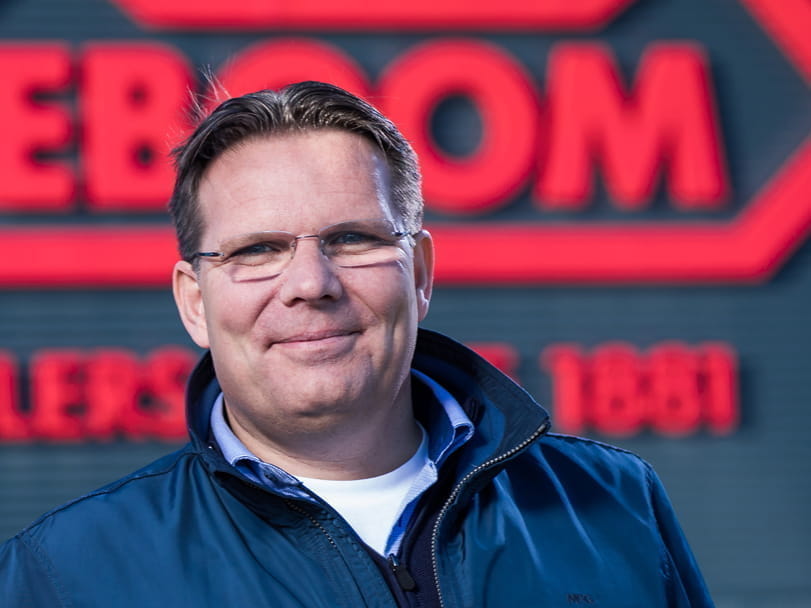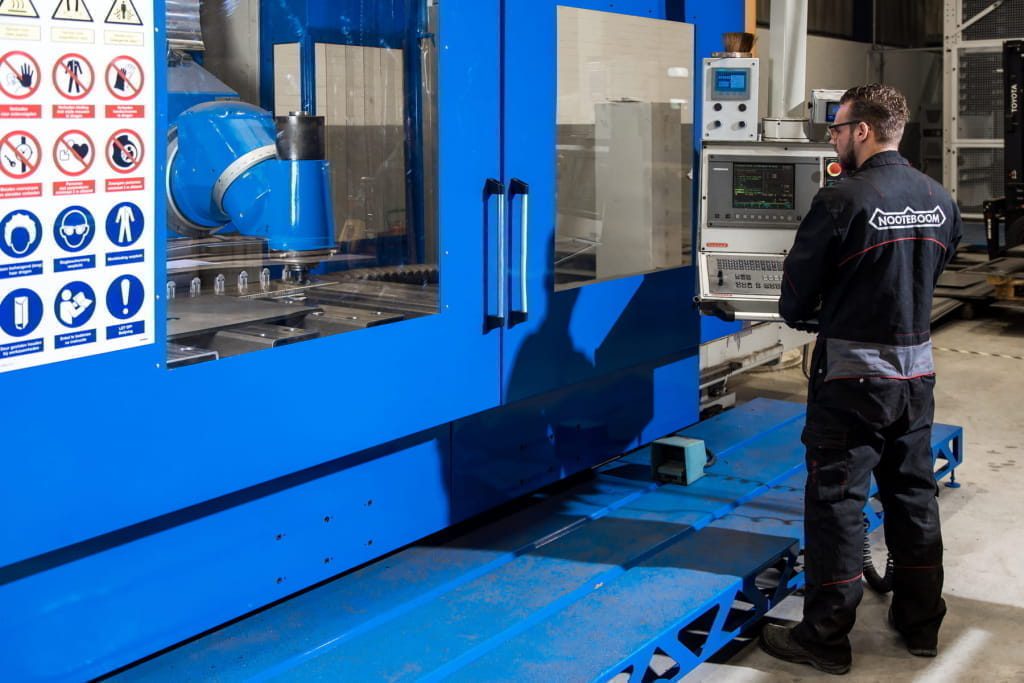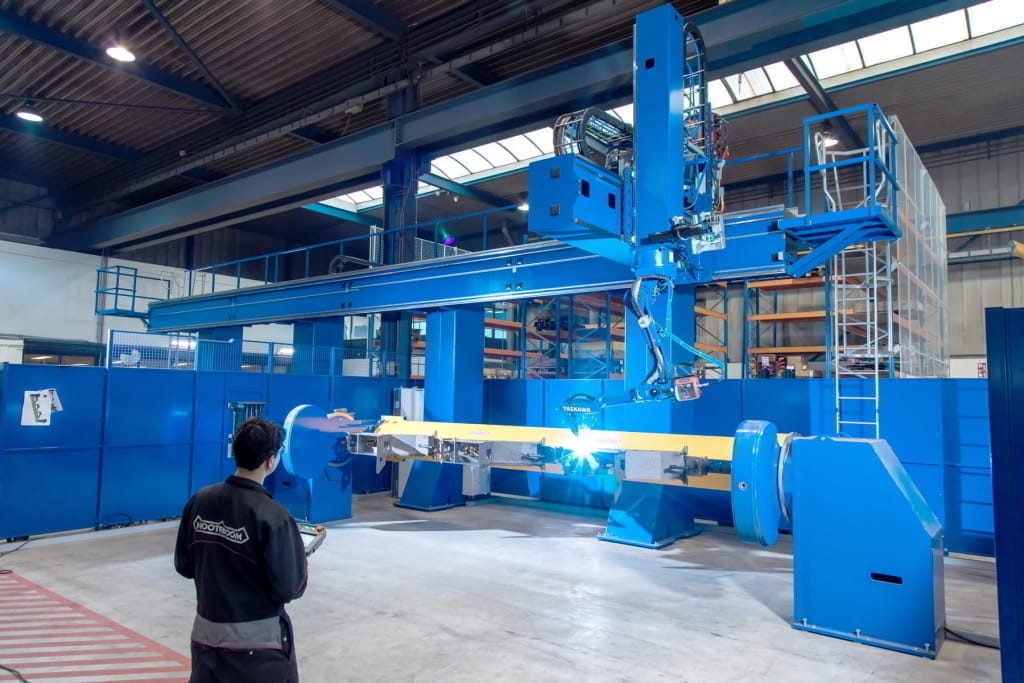Nooteboom Components is the name for the fully automated department at Nooteboom Trailers where components for trailers are produced. One of the existing production halls has been completely renewed inside. An interview with Raymond Belderink, CHIEF OPERATIONAL OFFICER at Nooteboom Trailers.
Nooteboom Components – Quick Response Manufacturing
Ultramodern machinery for manufacturing vehicle components were installed In this hall, including a laser cutting machine, two new press brakes, a milling machine and a welding robot. Nooteboom Components works according to the ‘Quick Response Manufacturing’ method. This QMR-method is primarily aimed at reducing lead times in the production. But it also has a positive influence on the efficiency of the components’ production.
Why Nooteboom Components?
Raymond: “Nooteboom Components was established for a number of reasons. In the coming years we aim to increase the production and reduce the lead times in the factory. We also want to produce with a higher, consistent quality. And, just as important: we want to make sure that our employees work in pleasant and safe conditions.”
How did the process to automate the production start?
Raymond: “In 2016 we selected four persons who are involved from different perspectives in the production . Each of those four persons had specific knowledge about the overall production process. For the welding robot we asked three questions: which robot, which welding process and which software? Based on these first discussions we compiled a list of questions for various suppliers. Our demands were high and after initial consultations it turned out that half of the suppliers were not able to meet our requirements. After another round of consultations only two parties were left.”
Which role in the choice does the software play?
Raymond: “Nooteboom Components is a highly automated department. The software should make it possible to send the data virtually straightaway from the engineering department to the machines. For our software we don’t depend on one single supplier or one single make of robot. We ended up looking more closely at the integration of the software than at the machines. The software must offer many possibilities but it should also be user-friendly for the employees who directly work with the machines.”
Which new machines have been installed ?
Raymond: “This is our first step in the automation of the production. To take this step we have bought five machines: a laser cutting machine with two storage towers, two press brakes, a milling machine and a welding robot. Nearly all the machines work with the same software and they can communicate with each other. The laser cutting machine is equipped with two storage towers, one of which is intended for storing steel sheets with a thickness of up to 25 mm. In the other one the cut panels are automatically stored to be selected at a later stage for further processing. The cutting process is fully automated and still keeps going while the operator has a break or goes home at the end of his working day.”
Why two press brakes?
Raymond: “The two press brakes are identical but one is a left-hand version, the other a right-hand one. We chose this option because trailers have many components that are identical but a mirror image of each other. Now we can – without changing the blades – make the components for the left and right hand-side of the trailer at the same time. The press brakes recognise every piece of steel plate, because during the cutting process a QR-code is burnt in the sheet. We have also paid much attention to the ergonomics. Every machine has two displays. One shows the data for the product, the other displays the steps of the procedure. The press brakes are equipped with several laser systems for high-precision processing and to safeguard the safety of the operator.”
The milling machine
Raymond: “When thicker plates are welded a bevelled edge must be applied to ensure an optimal weld. Magnetic plates make it quick and efficient to clamp the plates . The milling machine too is automatically set to the QR-code that is burnt in the material.”
Fully automatic robot for the first time
Raymond: “Yes, this is the first one, but in the coming years several robots will be used in our production. Our welding robot is equipped with two stations. At station 1 the welding of the next component is prepared and at station 2 the welding takes place. The robot is suspended from a rail-mounted frame which allows easy access to all welds. The robot is equipped with a system for changing the welding torches. By changing the torches automatically the wire and position of the torch can be adjusted to suit different materials and applications. All machines are connected to a network so that operators are automatically informed if there is a malfunction.”
What does this mean for the planning?
Raymond: “Traditional production companies work with strategic planning, with lead times of at least six to eight weeks. In the coming years Nooteboom will use dynamic planning, enabling us to constantly adjust the production process. In order to take that step we put a few process engineers to work in 2017. We also discussed with the engineers all the possibilities available to us with the new machinery. For some of them it was inspiring to realise the potential of a modern milling machine.”
What is the current state of the process?
Raymond: “In 2018 we started to put our newly acquired knowledge into practice. Many components went back to the drawing board. The result: they are less complicated to produce, lighter, but often stronger too. We are making excellent progress but after all we are only in the pilot phase for our final process optimisation. The plans for the next steps to take will follow after the evaluation.”
Can the welding robot weld high strength steel?
Raymond: “For some kinds of steel it is important to first heat the material. In order to ensure the steel has the right temperature we are going to install a heating furnace. We can also change the welding wire automatically when we weld components made of high strength steel.”
What advantages offers the automated production to the engineers?
Raymond: “With the new software the engineers can see much more during the design process. It’s quite simple to check whether the entire component can actually be made with the robot. We can also design different versions of a component and check the pricing. When the engineer is finished, the software automatically makes a list for the various processing procedures. Previously it was not always clear whether a good-looking design by an engineer could be produced efficiently. This new software still leaves room for creativity, but at the same time checks are made to make sure the design meets the conditions within the production process.”
The latest development?
Raymond: “We are trying out Cobots, which stands for Collaborative Robot. A Cobot is a flexible, smaller robot that can make the work that people do easier and less demanding. With a Cobot the repetitive tasks in the production can be programmed. This physically lightens the workload of the employees. It is easy to programme a Cobot. In most cases you have to show them the work instructions only once. Because a Cobot is much cheaper than a robot it is of interest to include Cobots in the production.” The extensive automation of the production of components offers many advantages. First of all, the lead times are reduced significantly. In many cases even from weeks to a few hours. Automation also makes the production flexible and the components meet very high quality standards.
Raymond: “At first some of our employees were afraid that automation of the production would put their jobs at risk. That idea has disappeared completely. We have to automate because in the coming years it will become increasingly difficult to find skilled technical personnel. Our employees now understand the need for automation, because the quality is improved and with the new machines some of the demanding and dirty jobs can be avoided. I can safely say that everyone – from management to engineering and production – is extremely satisfied with the steps we have taken. This is important progress.”









